Sept. 14, 2017 An update on the unhealthy cues sent to kids with BoxTops for Education, via Harvard Chan School of Public Health podcast which nails the core problem quite succinctly. The program is “Leveraging poor school funding and caring parents to promote the purchase of poor quality foods.”
Also, here’s fresh research on the Gatorade/hydration spin-spotting from the folks at CrossFit…a very thorough indictment of the use of science misinformation to promote a twisted ‘manufactured need.’ More below…
Aug. 20, 2015 Update More Back to School branding boondoggles…
Remember when the G-force Gatorade tribe was caught red-handed with their marketing machinations of hawking sugar hydration to students over regular water?
Well, they’re at it again, this time sneaking their sports drinks message into schools as ‘hydration education’ which is perhaps one of the biggest shilling shenanigans of sugar I’ve seen a corporation have the audacity to trot out under the guise of health. (gah!) Thank you for the spin-spotting Bettina Elias Siegel. Heavy sigh.
Feb. 4, 2015 Update Add the NFL into the in-school curriculum infiltration and marketing mix as CCFC has just released a powerhouse study, “Out of Bounds: The NFL’s Intensive Campaign to Target Children.”Also don’t miss this excellent account of the Super Bowl sacks from parents crying foul on the play in Casey Hinds’ scorecard detailing junk food ads. More to come from both of these players.
Sept. 19, 2014 “Our school doesn’t take advertising,” said the administrator with the handmade box sitting on her desk marked “BoxTops For Education.”
As I winced at the disconnect between what school officials perceive as “commercialism” and the pervasiveness of in-school branding, it made me think of that “fish can’t feel that water is wet” analogy of environmental permeation. I shook my head with a sigh, thinking, “Well, that’s the free star in the middle of the branding bingo board…”
Adults clearly don’t see the branding bonanza seeping into schools any more than the kids do. It’s like urban wallpaper unless you’re purposely looking for it. That’s what we’re here to do today. Raise awareness. Shoulder shake students, parents and educators out of complacency. And take action when warranted. (CSPI’s visual shows only a smidge of the $75B Back to School branding bonanza, according to the National Retail Foundation)
In the eight years I’ve been writing articles like “School Sit Ups Sponsored by Soda and Snacks” or McDonalds Pays Off Good Grades or CCFC’s calling out of the brazen embedding of an entire coal curriculum in a Scholastic pay for play ploy to teach about “energy” and vapid Bratz books like “Catwalk Cuties” and such marketed at Scholastic Book Fairs I’ve only seen the branding infiltration get more seamless and stealthy.
Let’s start with the obvious “why should I even care” question. After all, what’s the matter with a few partnership deals if they help funding, right? Depends on the lens in your viewfinder…
Why Does In-School Commercialism Even Matter?
 As marketers salivate at the “triple play” of tapping students, parents, and teachers all at once during the school day, critical thinking is key in all three areas for a hefty “heads up” on both overt and covert commercialism.
As marketers salivate at the “triple play” of tapping students, parents, and teachers all at once during the school day, critical thinking is key in all three areas for a hefty “heads up” on both overt and covert commercialism.
From “unbranded/white label” efforts, to trends toward specialized curriculum (also altering University education) it’s imperative to understand promotional tactics being used online and off AND weigh the cost/benefit analysis beyond cash-strapped schools to see the societal impact.
Institutions like schools and hospitals used to be sacrosanct environments free of influence by big brands (or big pharma) incentivizing care providers. Would you want your doctor to deliver your health care knowledge through the lens of vested interests? Teachers hold a similar role with students in how they position information, ESPECIALLY within curriculum itself.
Consider the hospital controversy of freebie infant formula and coupons gifted in nurseries resulting in fewer newborns breastfeeding, as new moms perceived it as both a convenience, and medically sanctioned recommendation since it came from the institution itself. Student commercialism is the same way. Kids look up to their teachers and schools hold credibility and clout with parents who assume it “must be okay” if the school is supporting it.
Credibility and objectivity is compromised when commercial solutions seep in with the power of suggestion to instill habits, alter behavior, and even shift the knowledge base with different outcomes.
Hiding in Plain View
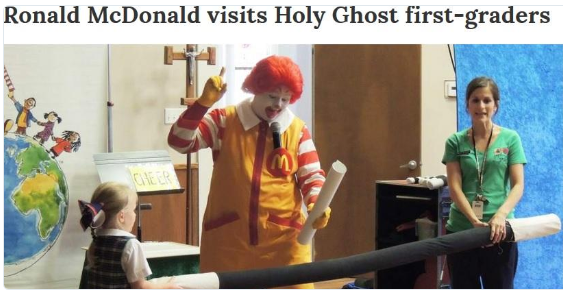 It’s easy to spot food marketing in schools and cry foul when bright flashy Ronald McDonald mascots are stumping for wellness or leadership programs, or giant costumed Chick Fil-A or Red Robin poultry flapping around feathering the fundraising tillers…but many of today’s “partnerships” are much more subtle and systemic.
It’s easy to spot food marketing in schools and cry foul when bright flashy Ronald McDonald mascots are stumping for wellness or leadership programs, or giant costumed Chick Fil-A or Red Robin poultry flapping around feathering the fundraising tillers…but many of today’s “partnerships” are much more subtle and systemic.
Parents rarely “notice” nuanced marketing like the pouring rights of “Coke vs Pepsi” at school concessions (even though 80% of public high schools have pouring contracts) much less school library makeovers by big box corporate retailers like Target, product placement in texts and even standardized Common Core tests, junk food scholarships and sometimes even the uniforms, fields or schools themselves ‘gifted’ through logos and naming rights.
Ads on sports team school scoreboards don’t even get a blink unless it veers into controversy like this school scoreboard ad for gun ammo, where a California high school got wrist-slapped awhile back, deemed “inappropriate” at the district level. Oddly enough, it seems alcohol and tobacco (and firearms) are the ONLY advertisers consistently off-limits to schools across the nation, the rest appears to be handled at the local district level.
Scavenger Hunt: What’s Harder to Find?
It’s not difficult to fill up a ‘branding bingo’ card in a scavenger hunt for in-school marketing and after school ‘enrichment’ these days …but ambient advertising and brand exposure gets complicated.
Is it any wonder that parents are outplayed…And played out with exhaustion keeping up with who’s marketing what to whom during the school day?
As a media maven with a fondness for digital, I’ve had to ‘check myself’ multiple times to keep from giving a hallpass to brands tethered to ‘education’ agendas, because critical thinking keenly reminds it’s all still ‘in-school commercialism,’ and needs viewed with a lens of objectivity sans weighted bias.
Media Giants and Digital Platforms
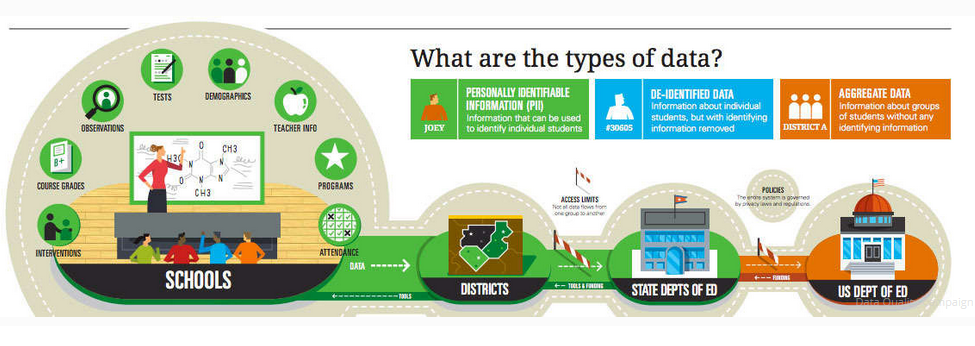 In an era where tech is often trumpeted as solution-based savior, laced with policy pushes and educrat blunders (like the “give every child an ipad” L.A. school district debacle) tech titans need their own brand of commercial scrutiny in a Back to School walkthrough, as much of their ‘product’ is out of sight and ‘under the hood’ in the form of deep data collection on students.
In an era where tech is often trumpeted as solution-based savior, laced with policy pushes and educrat blunders (like the “give every child an ipad” L.A. school district debacle) tech titans need their own brand of commercial scrutiny in a Back to School walkthrough, as much of their ‘product’ is out of sight and ‘under the hood’ in the form of deep data collection on students.
What are the types of data? How will they be used? Does it help or hinder and how? Where do privacy rights and student/parent policies come into play? How can we ensure security and preclude commodification? EdSurge has a great visual guide to student data privacy here, and Education Week has a helpful news roundup to debrief at a glance.
Then there’s curriculum creep where aspects of commercial ventures trickle into teaching.
“53% of elementary schools and 12.5 million students are being taught about food and nutrition by the food industry,” cites Yoni Freedhoff in this poignant post on Civil Eats citing the use of the Healthy Weight Commitment Foundation (HWCF)–curriculum, which is a “food industry funded coalition of over 250 organizations including corporate heavy hitters like the Grocery Manufacturer’s Association, Kraft, General Mills, Nestlé, Kellogg’s, Mars, Unilever, The Coca-Cola Company, and PepsiCo”
Beyond K-12, parents of older teens might want to check out Corporate Cash Alters University Curricula in the Wall Street Journal or this one from Food & Water Watch “Higher Education Brought to You by the BioTech Industry” connecting the dots on research: “You find the names Monsanto, Cargill and Tyson emblazoned on university buildings around the country, and corporate representatives sometimes play key roles in determining the research direction of our agricultural colleges. In its most benign form, industry rolls up on campuses with programs like Hunger U or Biotech University.”
 Then there’s the management of some of the elementary schools themselves. Do we really think that if the Disney Institute comes to schools to teach administrators about efficiency and engagement that some of that magic dust won’t be left behind in the classroom? And what about Target’s makeovers of 175+ school libraries with immersive branding in the name of funding?
Then there’s the management of some of the elementary schools themselves. Do we really think that if the Disney Institute comes to schools to teach administrators about efficiency and engagement that some of that magic dust won’t be left behind in the classroom? And what about Target’s makeovers of 175+ school libraries with immersive branding in the name of funding?
Don’t forget the ambient ads around school…
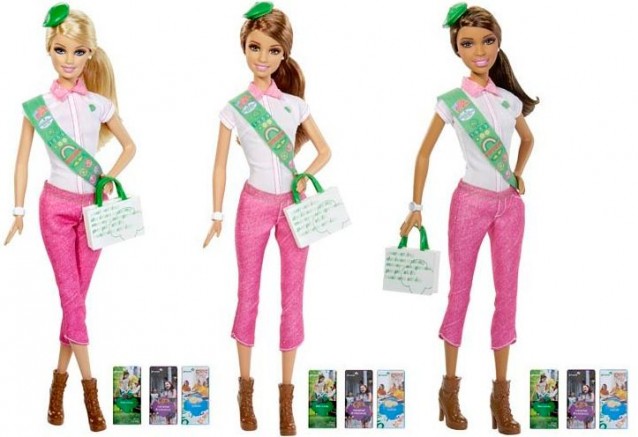 Subtle branding shows up indirectly via after school meetings, clubs, uniforms, lunch time and such.
Subtle branding shows up indirectly via after school meetings, clubs, uniforms, lunch time and such.
We’ve already seen what’s happened when respected organizational institutions like the Girls Scouts cozy up to brandwashing partnerships like Mattel, with a new “Barbie badge,” and “I Can Be” career dolls, as the toy company tries to sell the ‘empowered’ pitch, now complete with a startup entrepreneur schtick (I lost my GS cookies on that one). The Girl Scouts have also just launched drinkable cookies via Nestle coming in at 48grams of sugar. Just ducky.
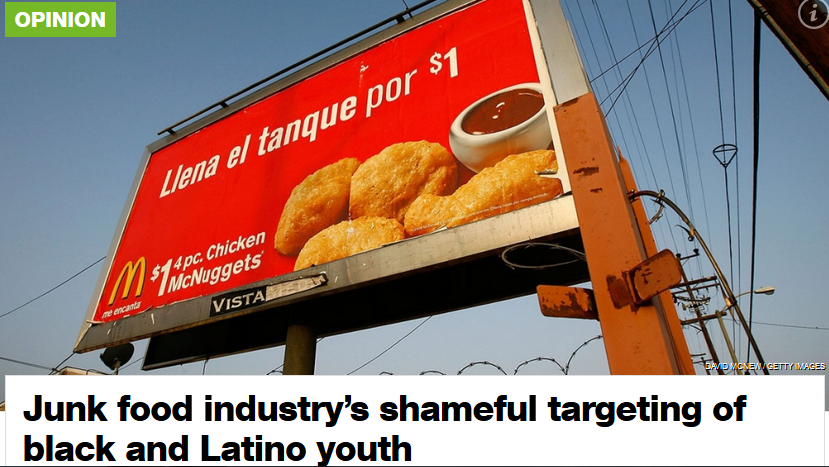 Last but not least in campus commercialization…
Last but not least in campus commercialization…
What seems blatantly obvious but needs repeatedly pointing out as “hidden” is the ubiquitous marketing taking place at the lower income schools.
In spring 2014 Al Jazeera called out the problem point blank as the “shameful targeting of black and Latino youth.”
Prior to that, five-year trend tracking from Journal of American Medical Assoc (JAMA Pediatrics) noted coupons and exclusive beverage contracts are “significantly more likely for students attending schools with mid or low (vs high) student body socioeconomic status.” (’07-’12)
In other words, the most vulnerable populations with the highest obesity problem are being served up some seriously unhealthy messages, from Coke Rewards to SunnyD.
What Do Parents Think About Commercialism in Schools?
Or DO They Think About It At All?
All too often adults feel a déjà vu 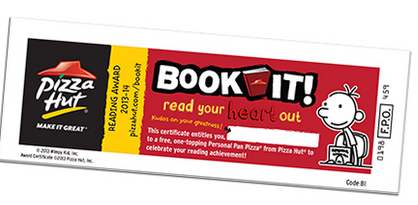 form of “Didn’t we already take care of this?” (from school partnerships to vending machines) only to find out policy that once passed has been either watered down, forsaken by lobbying efforts, upended at district and local levels, or reframed as “better for you” nutritional improvements.
form of “Didn’t we already take care of this?” (from school partnerships to vending machines) only to find out policy that once passed has been either watered down, forsaken by lobbying efforts, upended at district and local levels, or reframed as “better for you” nutritional improvements.
When I interviewed about a dozen low income parents/reduced lunch plan participants about commercialism for ‘Back to School’ week it was once again evident that the socioeconomic divide is more than ‘digital’ when it comes to these concerns.
In fact, these already overwhelmed parents DID use the commercial offers and coupons promoted, (Office Max, etc) and though they returned the humongous stack of paperwork for Back to School Night signed they admitted most policy was unread (some forms were left unfinished, some had misunderstandings, some didn’t have access to the ‘online filing’ the teacher had asked for, etc.)
 Asked about food marketing and after care programs, the majority acknowledged processed pouch snacks were “probably not so good but better than nothing.” It’s the junk food hydra blended with socioeconomic time-strapped parents with cash constraints all over again.
Asked about food marketing and after care programs, the majority acknowledged processed pouch snacks were “probably not so good but better than nothing.” It’s the junk food hydra blended with socioeconomic time-strapped parents with cash constraints all over again.
Part of the lack of parental awareness of in-school commercialism may also be the deluge of social media tools, apps and platforms to communicate WITH schools, without talking in depth ABOUT schools.
Important protocols, policies and privacy practices that influence children outside their own homes the vast portion of their waking day often aren’t being addressed in open forums or Q&A but instead, given as “read and sign” paperwork that usually gets rubber stamped without any education or understanding.
In a middle class demographic, very few parents are shrugging off predatory practices as inevitable and some tactics were deemed more offensive than others. This Yale Rudd Report surveying parents on food marketing is insightful. And this new Pew Report shows parents support healthier school food policies by a 3 to 1 margin.
I reached out to Facebook groups from a few aligned parenting communities to ask if they’d post a request for parents to share what’s happening in THEIR schools across the country. You can read some of the responses from CCFC here and Pigtail Pals here. Here’s one snapshot that sums my views from K-12 days in a nutshell, viewing corporate stalkers and ‘ad creep’ as a threat to their parenting style…
Wren Drexler writes passionately on CCFC’s Facebook thread:
“Dominos ‘partners’ with my daughter’s school. We get tons of flyers, there are signs everywhere, kids come home with stickers on their shirts on designated “Dominos night.” Also, the Chik-Fil-A mascot is often milling about with the kids during car line. We get those flyers too. But I think one of the nastiest predatory practices, and one not often mentioned, are these so-called fundraising companies. Cherrydale Farms is the one that does this locally. The loathing I feel for those bloodsuckers. How dirty is it that they dangle unattainable prizes so our kids will excitedly volunteer to be unpaid salespeople for them, while they offer schools some paltry tidbit for pimping out our kids. How is this not illegal?”
Of course, one has to be careful throwing around ‘what’s legal’ in policy and practices, because forbidden fruit triggers media hype about ‘food police’ and few are fans of bans, precisely due to contraband silliness with heavy-handed legal beagles prompting headline news frenzies that don’t help anyone. (except maybe the tongue wagging media pundits baiting outrage for ratings)
What’s The School Policy? Who Holds the Power?
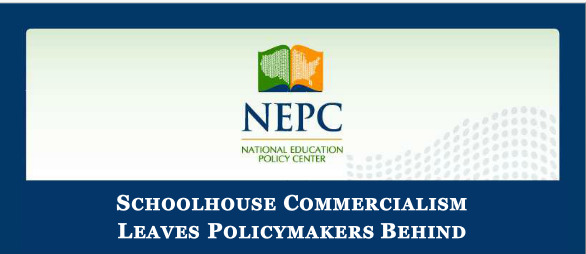 As the Nat’l Education Policy Center Report on Schoolhouse Commercialism notes, the national dialogue is not shifting into action in any significant manner.
As the Nat’l Education Policy Center Report on Schoolhouse Commercialism notes, the national dialogue is not shifting into action in any significant manner.
Likewise, when it comes to food and beverage marketing to children and adolescents specifically, even when the Berkeley Media Studies Group reports on childhood obesity, nutrition, and school lunches, we still CONTINUE to see the push/pull persistence of schools hawking junk food unchecked…even with this fall’s new USDA “smart snacking” guidelines. What gives?
Question Authority: PTSA, Boosters & Beyond
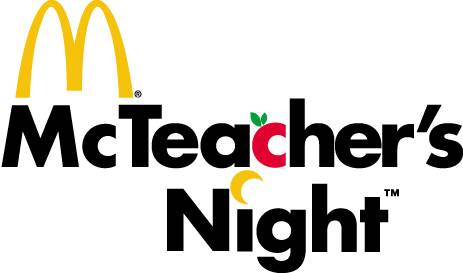 With a fresh start and a new school year, it’s the perfect time to “question authority,” and see who’s making the decisions.
With a fresh start and a new school year, it’s the perfect time to “question authority,” and see who’s making the decisions.
Often backdoor branding sneaks in through the PTSA, a handful of volunteer parents who may not have the same ‘big picture’ awareness about wellness education, choosing events and fundraisers by popularity or proximity.
Ask at back to school night how to seed healthier ideas, uncork conversations, and pushback and sound off when you notice eyebrow raising zingers you want stopped NOW. Example?
McDonalds led the way in mining students with ‘McTeacher’s nights’ and incentives for good grades on kids’ report cards which I wrote about here but they’ve shifted their repeat offender tactics to outright deception when their CEO claimed they absolutely would not be marketing in schools. (Ronald’s been in schools MANY a time thereafter)
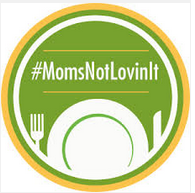 If you’re of the ‘stop selling fast food to kids in school’ mindset, please join the fabulous “#MomsNotLovinIt” activism on Twitter, and take action here to tell McDonald’s CEO to stop clowning around with lies about not marketing in schools when Ronald’s center stage in kids’ assemblies.
If you’re of the ‘stop selling fast food to kids in school’ mindset, please join the fabulous “#MomsNotLovinIt” activism on Twitter, and take action here to tell McDonald’s CEO to stop clowning around with lies about not marketing in schools when Ronald’s center stage in kids’ assemblies.
It’s also early enough in the year to lay the groundwork for funding alternatives and address the tough questions of cash-strapped schools that have relied on corporatization, vending machines, and ‘alliances’…
When resources are taken away and school budgets are upended without replacing revenue, where do schools turn? What does a healthy corporate partnership look like? Is there one? If so, what models work and why? How can we level the playing field if schools don’t even own one? This Seattle pediatrician on his site Childhood Obesity News brings up interesting policy points about restrictions on school pouring rights contracts and things to consider when resource equality is random, and kids end up as the biggest sports penalty…
With media literacy and a keen eye following the money trails, let’s at least try to get all parties “schooled” on vested interests, influencers, and undue harm so we don’t end up with a lens like,
“This education is brought to you by…”
Commercialism in the Corridors:
A Checklist for In-School Commercialism
by Amy Jussel, Shaping Youth
Food Marketing: Does Your School Have…
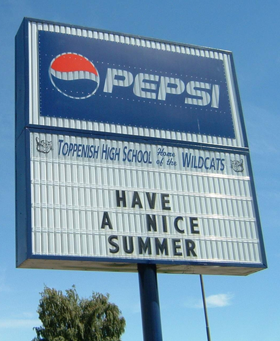 School signage with advertising
School signage with advertising
PTSA food fundraising promos on school billboards
Campus vending machines (new USDA smart snack nutrition policy fall ’14)
Copycat Snacks: Health halos as industry serves ‘new improved’ smart snack compliant versions
Concessions and contracts for Pepsi vs Coke pouring rights
Preferred school food partnerships with purveyors of pizza, fast food franchises
UPC code and box top packaged goods incentives (‘labels for education’ etc.)
Sports scoreboards, sponsorship of teams/clubs/equipment
Sports drinks, beverage ads, logos and inaccurate information (e.g. Gatorade tells kids to avoid water for hydration)
After school enrichment programs w/snacks or embedded curriculum (e.g. Junior Achievement w/Gatorade ties)
Class competitions for food rewards, student ‘goals,’ sponsored events and incentives
Grocery store sponsored food drives
Digital food marketing to students embedded in school related sites
Outsourced “wellness programs and life sciences” with “better for you” nutrition tethers
Branded fundraisers with shockingly abysmal earnings (67.4% made no income at all?)
Fitness challenges with commercial ties to protein bars, exercise facilities, gear
Charity and prosocial campaigns featuring iconic fast food mascots (e.g. Ronald McDonald House)
Nutrition curriculum sponsored by food industry ties (e.g. American Nutrition Dietetics trade organization, or councils/foundations promoting specific vested interests, e.g. dairy, meat, fruit, ag, etc. or using the “Energy Balance” catch phrase)
Food advergaming embedded deep inside content layers of games, virtual worlds, ‘health’ class
Free teaching materials, branded book covers, licensed cartoon tissue boxes/logos
Food ads on school buses, school bulletin boards, gyms, inside edu-gaming via computer lab
Channel One Network, heavily commercialized daily TV newscast shown to “12000 middle, junior and senior high school students”
Corporate Classrooms: Does Your School Have…
(Packaged Goods, Tech Gear, Branded Texts, Scholarships & Challenges)
 Public School Library Makeovers (e.g. Target’s screensaver logo resides on all tech via Take Charge of Education program, posters, Meals for Minds program, and back to school supply campaign, etc.)
Public School Library Makeovers (e.g. Target’s screensaver logo resides on all tech via Take Charge of Education program, posters, Meals for Minds program, and back to school supply campaign, etc.)
Public School Playground Makeovers (from Danimals to KFC)
Sponsored Tech Gear From Smartboards and laptops, to iPads and phablets, tech alliances can mean big tax breaks for corporations who provide considerable gear and ‘adopt’ schools with branded line extensions, apps, and products following suit; pay attention to single vendor dominance and pay for play exclusivity)
Sponsored “Challenges” & Scholarships: (Toyota, Coke, Walmart, Dell, and some wild ones)
Brand Ambassadors: (showing up in high schools as clubs, special interest groups, market researchers, in college much more blatant opportunistic in peer to peer viral word of mouth)
Freebies/Sample Sizes/Coupons(health class/life skills; PE/puberty transitions in gym/sports trial sizes especially; soap/deodorant, mouthwash, locker gear)
Back to School Retail Blitzes: (School supplies, preferred providers, prosocial charity tie-ins) Enjoy lots of ‘insider insights’ via marketing trade journals touting the “$1B kids market” and the slice of the “educational spending spree” despite those pesky consumer “watchdogs” (!) They dish on “shopping habits” via infographic and highlight back to school brand biggies(Office Depot, Office Max, Target, PacSun, Dell, Gap etc.) in this informative 2014 Adweek roundup
Back to School PTSA Fundraisers or Sports Boosters: Ask parent orgs how they choose their vendors and who has final approvals; THIS is where considerable commercial leakage seeps onto kids, as district policy people can wash their hands of responsibility while pairing with “Make some dough” cookie, cake, pizza puns teaming with corporate sales, or “sweet, hot deals” from candy to coffee franchises, and a plethora of turnkey fast food national programs; see FoodMarketing.org from Yale Rudd Center for more
Media Giants, Data Collection: It’s a virtual arm’s race of the tech titans heating up that parents should be EXTREMELY aware of in terms of student data privacy, behavioral datamining, and personal student information as it pertains to COPPA compliance, 3rd party apps, and beyond. 21st century digital learning is part and parcel of our new world order, but READ and ASK about what’s being used where, as you sign the mounds of parental consent forms.
From Google for Education training, tools, and full tilt Google Classroom/gmail suites to Apple’s own brand of apps, tunes, and touchscreen educational swiping, this “Day in the Life of a Datamined Kid” post on Marketplace captures the Quantified Student graphically. (double-entendre intended) Most parents sign digital permissions unread, akin to the mousetype in a Terms of Service contract…but it’s important to debrief yourself with at least a primer (this easy one is from our friends at iKeepSafe, “What parents should know about student data”)
For a deeper dive into the data depths, here’s the latest on student data privacy from Education Week, and though this one from the Verge is baiting outrage with the inflammatory headline, “Google is coming for your children” it DOES sheds some light on why these issues matter at diff ages/stages and what it all means. Finally, this excellent Edsurge Guide to Student Data Privacy: How and Why Student Data is Collected has a fabulous visual at a glance with extensive sidebar of facts, laws, and resources. Privacy infovores should read them all.
Education: Does Your School Have…
(Corporate Curriculum, Sponsored Reading/Literacy Incentives, Toy Laden Book Fairs)
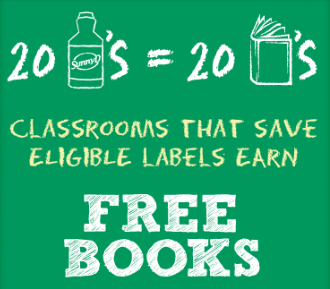 I vote these two “most egregious” food marketing disguised as education for 2014…
I vote these two “most egregious” food marketing disguised as education for 2014…
Pizza Hut “Book It” Program (“reaching hundreds of thousands of educators across the country, over 30 years”)
SunnyD Book Spree: (20 labels for 20 books promo)
They particularly stick in my craw for hawking empty calorie crud and interfering with the rights of families to NOT have school undermine their children’s health.
SunnyD and Pizza Hut follow close behind McDonalds for their brazen balderdash in the name of books and literacy, with massive longevity and immersive reach of their programs which have upended counter-marketing and health literacy efforts I’ve PERSONALLY used in “Title One, low income, high risk, obesity intervention classrooms”…
 There’s nothing quite like explaining in detail with hands-on “Dare to compare: gross out games for good nutrition” to illustrate why SunnyD is NOT even REMOTELY to be mistaken for orange juice, (it’s a FLAVORED orange- COLORED drink laden with salt and sugary corn syrup as the #2 ingredient, with only 5% juice in the whole shebang!) only to then step outside the classroom for recess to see banner ads encouraging purchases to earn school books!
There’s nothing quite like explaining in detail with hands-on “Dare to compare: gross out games for good nutrition” to illustrate why SunnyD is NOT even REMOTELY to be mistaken for orange juice, (it’s a FLAVORED orange- COLORED drink laden with salt and sugary corn syrup as the #2 ingredient, with only 5% juice in the whole shebang!) only to then step outside the classroom for recess to see banner ads encouraging purchases to earn school books!
Facepalm. HeadDesk. Double whammy: Undermining kids wellness AND negating my probono pilot program of media/health literacy games. Sunny D’s marketing also touts empty label lingo about ‘added vitamins and nutrients’ that blur the lines for parents duping them into believing they’re giving their children something ‘nutritious’ with the added bump of credibility coming from school sanctioning.
4 out of 5 parents I spoke with after my low income health literacy nutrition session were of the opinion that “It must be good for kids, because they wouldn’t let it in school otherwise.” Predatory marketing with parental undermining in a one two punch. Yes, this is personal.
Center for Science in the Public Interest didn’t mince words in this CBS piece at all, boldly contending SunnyD “encourages families to consume a drink that promotes diabetes, weight gain, and other health problems.”
Yep, that about nails it. Time to trot out their “liquid candy” report as it’s apropos and needs brought forth to educators and school administrators front and center to hold them accountable for undermining kids health.
What can YOU do to stop this? Again…Take action.
The onus being placed on parents to “reteach” healthy habits, deconstruct dumb ‘partnerships’ and outsmart brilliant marketing minds trained in persuasive tactics in order to “deprogram” and UNschool kids when they come home each day is beyond burdensome, it’s a travesty placing profits over public health.
Education/Literacy List, cont…Does Your School Have…
Reading challenges linked to food rewards
Literacy incentives with coinage and consumption (e.g. edu games with prizes, ads, portals)
Book Fair fundraisers with cross promotions of toys and tchotchkes
Outsourced curriculum via vested interests (corporate, STEM, tech, food foundations, etc.)
“Curriculum Connections” partnerships, alliances (From beloved brands like Schoolhouse Rock, Bill Nye the Science Guy and Steve Spangler to Disney’s vast array of education oriented games, products and connected learning games and the latest edu portals, digital learning and deeper inquiry, try to find out what’s productized with “upsell potential” so you’re not caught by surprise)
Classroom Editions of Media: Kids versions of magazines and websites: Time, National Geographic, and video/sites, from Discovery, Animal Planet, Scholastic etc. are all watch-worthy for ad content.
I almost tossed my daughter’s homework in K-5 thinking it was an ad, during the era of “Toyota’s Road to Reading” worksheets and Toyota Scion’s embedded in the “edutainment” virtual world of Whyville once upon a time. Today? This kind of branding encroachment into reading, school libraries, and even books and standardized tests themselves under the guise of ‘incentivizing’ literacy seems to be flying under the radar of the vast majority of adults and kids alike.
Industry Sponsored STEM/EdTech Coding Clubs (also note edu apps, virtual worlds/social media (plenty of opps for partner promos, cross-sell of tech platforms, upsell of similar content/ventures etc.)
21st Century learning is chock full of hackers and makers excited about new ways to learn, from World of Warcraft In-School and various “Learn to Code” computing curriculum opportunities, but commercial interests are tapping on the edge and tugging for mindshare, so savvy students and parents alike will be able to use critical thinking to prioritize commerce, innovation and ideology, while learning/collaborating and emerging with their own ideals. Minecraft, for example, has been the darling of STEM educators, as a commercial-free creative dream, as this piece notes it’s the “Video Game That Leaves You Alone” but with Microsoft’s new purchase of the company that built Minecraft, many are worried those days will be numbered, and are keeping a watchful eye. Stay tuned…
What Can You Do? Get Schooled on Commercialism.
A Mini- Roundup of Great Reads, Health Literacy and Helpful Tips
Controlling Junk Food Report: Case Studies of Schools Successfully Implementing Strong Nutrition
Digital Ads.org: Tracking how industry tracks kids in food and beverage marketing
AND Report: And Now A Word from Our Sponsors
Sports Snacktivism Handbook: Handy Parent’s Guide to Lobbying for Healthier Fare
When Schools Become Ads: Blogger Casey Hinds, US Healthy Kids
CopyCat Snacks in Schools: PHAI
Edweek Interactive: Which “Smart Snacks” Make the Grade w/new USDA Guidelines
CCFC How to Guide to Set Up Commercial Free Book Fairs/Fundraisers
The Lunch Tray Blog: Kids & Food, Inside & Out
NFH Consulting Blog: Food Policy/Nutrition-Exercise Advocacy
Public Health Advocacy.org: Examining the Data Behind Health Claims
Center for Science in the Public Interest
Food Marketing in Schools WorkGroup: Yale Rudd Center
Advertising in Schools: CCFC Factsheet Food Marketing & Childhood Obesity CCFC Factsheet
Eat Drink Politics: Michele Simon, Countering Industry Harm to Improve Public Health
Dieticians for Professional Integrity Facebook Page
Dr. Yoni Freedhoff’s Weighty Matters Site Holding Industry Accountable
Trends 2013 by National Education Policy Center
Visual Credits: Lead Graphic: CSPI, Ronald McD visits Holy Ghost/The Advocate.com, Types of Data Graphic-Edsurge, D’Think screenshot Disney Institute, Girl Scout Barbie/ThinkProgress, Latino Billboard: David McNew, Getty Images, Pepsi billboard-FoodMarketing.org screenshot, Public School Review/Pros & Cons of Ads in Schools All other screenshots from their respective sites as identified.
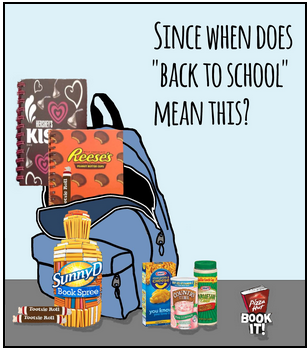









Speak Your Mind